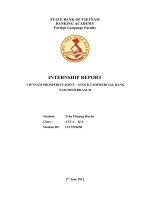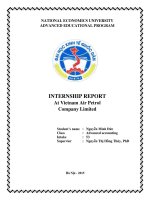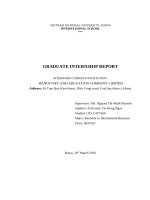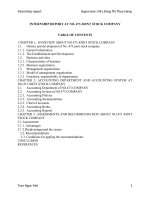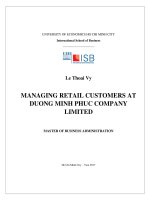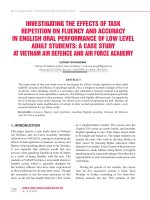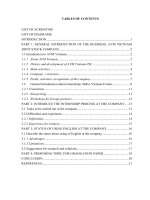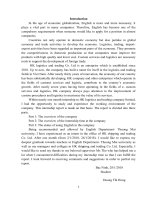INTERNSHIP REPORT at vietnam air petrol company limited
Bạn đang xem bản rút gọn của tài liệu. Xem và tải ngay bản đầy đủ của tài liệu tại đây (834.46 KB, 58 trang )
NATIONAL ECONOMICS UNIVERSITY
ADVANCED EDUCATIONAL PROGRAM
INTERNSHIP REPORT
At Vietnam Air Petrol
Company Limited
Student’s name
: Nguyễn Minh Đức
Class
: Advanced accounting
Intake
: 53
Supervior
: Nguyễn Thị Hồng Thúy, PhD
Hà Nội - 2015
Supervisor: Nguyễn Thị Hồng Thúy, PhD
Nguyễn Minh Đức- Advanced Accounting 53
1
Table of Contents
Acknowledgement 6
Introduction 7
1. OVERVIEW ABOUT VIETNAM AIR PETROL COMPANY LIMITED 8
1.1. Establishment and Development of Vietnam Air Petrol Company Limited 8
1.2. Business Activities And Management Of Vietnam Air Petrol Company
Limited 11
1.2.1. Business line: 11
1.2.2. Management 12
1.2. Financial Position And Operational Results Of Vietnam Air Petrol Company
Limited 14
2. ACCOUNTING DEPARTMENT AND ACCOUNTING SYSTEM AT
VIETNAM AIR PETROL COMPANY LIMITED. 18
2.1. Accounting Department At Vietnam Air Petrol Company Limited. 18
2.2. Accouting Application: 19
2.2.1. Acocunting Standards: 19
2.2.2. Accounting Policies: 20
2.2.3. Accounting Vouchers And Accounting Documents. 23
2.2.4. Accounts In Accounting System 27
2.2.5. Accounting Books: 30
2.2.6. Financial reports 32
2.2.7. Auditing In The Company 35
2.3. The Main Accounting Cycles Applied By Vietnam Air Petrol Company
Limited 35
2.3.1. Accounting for Inventory 35
2.3.1. Accounting for fixed asset 38
3. SOME REMARKS ON FINANCIAL ACCOUNTING MANAGEMENT AT
VIETNAM AIR PETROL COMPANY LIMITED. 41
Supervisor: Nguyễn Thị Hồng Thúy, PhD
Nguyễn Minh Đức- Advanced Accounting 53
2
3.1. Remarks on Organizational Structure of Accounting Department at Vietnam
Air Petrol Company Limited 41
3.1.1. Advantages of Organization of Accounting Division 41
3.1.2. Disadvantages of Organization of Accounting Division 42
3.2. Remarks on Financial Accounting Management at Vietnam Air Petrol
Company Limited 43
3.2.1. Advantages of Accounting Management 43
3.2.2. Disadvantages of Accounting Management 43
SOME RECOMMENDATION ON THE ACCOUNTING SYSTEM AT VIETNAM
AIR PETROL COMPANY LIMITED: 45
REFERENCE 47
APPENDIX 48
Supervisor: Nguyễn Thị Hồng Thúy, PhD
Nguyễn Minh Đức- Advanced Accounting 53
3
ABBREVIATION
HCM City: Ho Chi Minh City
Co. , Ltd: Company Limited
Supervisor: Nguyễn Thị Hồng Thúy, PhD
Nguyễn Minh Đức- Advanced Accounting 53
4
List of Table
Table 1: The scale and operating results of the Company over 3 years: 2011, 2012, 2013
Table 2: Business ratios over 3 years: 2011, 2012, 2013
Table 3: List of the managerial accounts code
Supervisor: Nguyễn Thị Hồng Thúy, PhD
Nguyễn Minh Đức- Advanced Accounting 53
5
List of Figures:
Figure 1: The development of the company
Figure 2: Management Diagram of the company
Figure 3: Accounting department firm Diagram
Figure 4: Process of record in general journal:
Supervisor: Nguyễn Thị Hồng Thúy, PhD
Nguyễn Minh Đức- Advanced Accounting 53
6
Acknowledgement
I express my deepest thanks to PhD. Nguyen Thi Hong Thuy for for taking part in
useful decision and giving necessary advices and guidance and arranged all facilities to
make life easier. Her guidance and support help me know the methods of information
collection about the company. She helped all time when we needed and he gave right
direction toward completion of my internship report.
I wish to express my indebted gratitude and special thanks to Mr. Le Duc Dao, the chief
accountant of Vietnam Air Petrol Company Limited, who in spite of being extraordinarily
busy with his duties, took time out to hear, guide and keep me on the correct path and
allowing me to carry out my industrial project work at their esteemed organization and
extending during the training.I do not know where I would been without him.
I also would like to express my thanks to the Advanced Educational Program in taking
students chance to have this internship program. It really is a good opportunity for learning
and self development. I consider myself very lucky and honored to have so many wonderful
people lead me through in completion of this project.
Supervisor: Nguyễn Thị Hồng Thúy, PhD
Nguyễn Minh Đức- Advanced Accounting 53
7
Introduction
Vietnam Air Petrol Company Limited (VINAPCO) was officially established in
July 1993, and was assigned importing and exporting petroleum products directly. After
more than 20 years, with nearly 1,500 staffs and employees, Vinapco is the best fuel
supplier to the airline at the Vietnam airport. Fuel is imported from the major international
markets such as Singapore, China,
With over 20 years operating experience in the field of petroleum, VINAPCO is really a
company that has developed constantly and continuously, and have many outstanding
achievements in production and trading. Moreover, accompanying wiht the development
of the company is a system of departments with efficient staffs, especially Finance and
Accounting department. With professional activities of the accounting system of the
company, VINAPCO is really a good choice for AEP’S internship program so I can study
about organizational activities of a large company with a full accounting system. Thereby,
I can learn a lot of practical experience to plan the next internship and for accounting
career path in the future. Therefore, I choose the company to intern, and report.
Supervisor: Nguyễn Thị Hồng Thúy, PhD
Nguyễn Minh Đức- Advanced Accounting 53
8
1. OVERVIEW ABOUT VIETNAM AIR PETROL COMPANY
LIMITED
1.1. Establishment and Development of Vietnam Air Petrol Company Limited
Vietnam Air Petrol Company Limited is a state-owned company located in the unit
of independent accounting member of the Vietnam Airlines Corportaion. In 1993, along
with the innovation of the country, Vietnam Air Petrol company limited (VINAPCO) was
established under Decision No. 768 / QD / TCCBD on 22.04.1993 of the Ministry of
Communications and Transport and officially operated in January 07/1993, after the
Department of Civil Aviation invested 31 814 billion of capital (including 19 010 billion
of fixed capital: 17 804 billion in working capital).
On 06/09/1994, the company was established under Decision No. 847 / QD / TCCLD of
the Minister of Communications and Transport and Decision No. 185 /CAAV on
20.01.1996 of Department of Civil Aviation of Vietnam
On 15/07/2010, the Vietnam Airlines Coporation made Decision No. 1438 / QD-HĐQT-
TCTHK changing Air Petrol Company into Vietnam Air Petrol Company Limited.
Currently, the company operates under a certificate of business registration No.
0100107638 on 19/07/2010 by the Department of Planning and Investment in Hanoi issued
on 19.09.2012.
Company’s name written in Vietnamese: Petroleum Company Limited Vietnam Airlines.
Company’s name written in English: Vietnam Air Petrol One Member Company Limited.
Company’s Name Abbreviation: VINAPCO
Head office: 202 Nguyen Son Street, Bo De Ward, Long Bien district, Hanoi City.
Tel: 04 38272316
Fax: 04 38272317
Email:
Website: vinapco.com.vn
The development of Vietnam Air Petrol Company Limited
Throughout the operation of the company, the criteria is slogan: "Safety - quality -
efficiency – development continuously" and respect the interests of customers, become a
reliable partner of the domestic Airlines and abroad ones.
Supervisor: Nguyễn Thị Hồng Thúy, PhD
Nguyễn Minh Đức- Advanced Accounting 53
9
From 01/7/2010, the company officially operated under the form of singe member limited
liability Company with a charter capital of 400 billion Vietnam dong, and was owned by
Vietnam Airlines. The objectives of the company is: To develop and maintain a leading
role in the field of fuel supply to Vietnam Airlines, the national airline and international
ones, and trade other petroleum products, operate the other industrial business sectors
effectively, preserve and develop the owner’s equity, complete other duties, make the
company growing, viable and developing in the economic socialist orientation market.
The development of the company is shown in the below chart:
Figure 1: The development of the company:
Supervisor: Nguyễn Thị Hồng Thúy, PhD
Nguyễn Minh Đức- Advanced Accounting 53
10
7/1993
• Vietnam Air Petrol company limited (VINAPCO) was established
1994-2010
• VINAPCO was divided into 3 subsidiaries supplying gasoline in North,
Middle, and South of Vietnam, and 1 subsidiary for transportation, and
supporting with strong material facilities, and modern equipments.
2009
and 2010
• Investing more than 20 trucks form USA, expanding more than 60,000
m2 for containing JET A1 gasoline, build a new modern laboratory in
Tan Son Nhat international Air port
• Improving new charging method
• Build a high quality staff
01/7/2010
• changing Air Petrol Company into Vietnam Air Petrol Company Limited
• with a charter capital of 400 billions Vietnam Dong
2012
• Purchasing 25 new transportation trucks, build a new tank with 6000
m2 capacity in Tan Son Nhat Airlines, build a new laboratory in North
Air Petrol Company.
• Purchasing many new equipments for business activities, and safety
• Improving warehouses, and supplying system for all airport operating
within Vietnam
• with total investment reaching 177 billions Vietnam Dong.
Supervisor: Nguyễn Thị Hồng Thúy, PhD
Nguyễn Minh Đức- Advanced Accounting 53
11
1.2. Business Activities And Management Of Vietnam Air Petrol Company
Limited
Business activities, rights, obligations and organizational management of the
company under the regulation about organization and operation of Vietnam Air Petrol
Company Limited (issued together with Decision No. 1444 / QD-HĐQT/ TCTHK on
15/07/2010 of the Board of Directors of Vietnam Airlines Corporation approved
organization and operation of Vietnam aviation gasoline company Limited).
1.2.1. Business line:
Vietnam Petrol Air Company Limited has full legal status under the laws of Vietnam,
registered business and activities in the form of limited liability company under the
Enterprise Law. On government assignment, company performs the rights and obligations
of the owners of the Vietnam Airline Corporations. Operational objectives of the company
is to develop, maintain a leading role in the supply of gasoline for Vietnam Airlines
corporations, the national airline and international ones, business efficiently, conserve and
develop stockholer’s equity of the company, complete tasks assigned by company owners,
grow in the socialist-oriented market.
Customers of the company are the parent company, Vietnam Airlines, other 3
national airlines and 56 international ones such as: VietJet Air, AirAsia, Jet Asia, Malaysia
Airlines, Thai Airlines, FedEX, Singapora Airlines, Korean Air, Thai Airways, Air
Hongkong, Silk Air, Dragon Air, Hongkong Airlines, Quatar Airways, China Eastern, Lao
Airlines, Jetstar Pacific, Vasco,… in Noi Bai international Airport, Tan Son Nhat
international airport, and other domestic airport from North to South. Now, VINAPCO is
the lead of gasoline supplier for airlines operating domestic.
Business activities of the company include:
- Wholesale of solid , liquid, gas fuels and related products
- inland waterways cargo transportation
- Warehousing and storage of goods (excluding real estate)
- Loading and unloading of goods
- Wholesale of machinery, equipment and other machine parts
- Wholesale cars and other motor vehicles
- Retail sale of cars (12 seats or less)
- Maintenance and repair of automobiles and other motor vehicles
- Selling spare parts and accessories of automobiles and other motor vehicles
Supervisor: Nguyễn Thị Hồng Thúy, PhD
Nguyễn Minh Đức- Advanced Accounting 53
12
- Retail sale of other goods in specialized stores (includes: oil, gas, coal used for specialized
stores)
- Pipeline transportation
1.2.2. Management
Management of the company is organized logically in the form of direct advisory
management:
Figure 2: Management Diagram of the company
Supervisor: Nguyễn Thị Hồng Thúy, PhD
Nguyễn Minh Đức- Advanced Accounting 53
13
Functions and responsibilities:
- VINAPCO operates under the control of the parent company, Vietnam Airlines
Coporation, with some supervisor to checking and monitoring its activities.
- The Board of members manage the company by issuing policies and making
decisions on major company issues.
- Genaral Director, and Vice general directors are responsible for planning,
organizing, staffing, leading or directing, and controlling company’s activities to
accomplish the goals and objectives that was assigned by the board of members.
Under the control of directors, there are 10 departments for each speciaized business
activities: Department of Human resource, Department of Finance and accounting,
Department of Import and export, Department of Investment and planning, Department of
technology, Department of Informatic statistics, Department of safety, External
relationship office, Party and Unions office, and Representative Office at HCM City.
- The department of Human resource: supporting systems are responsible for
personnel sourcing and hiring, applicant tracking, skills development and tracking,
benefits administration and compliance with associated government regulations.
- The department of Finance and Accounting: The business functions of this
department typically include planning, organizing, auditing, accounting for and
controlling its company's finances. The finance department also usually produces
the company's financial statements.
- Department of Import and export: This department is responsible for import, and
export activities, international transportation, and collecting information about
international market.
- Department of Investment and planning: It focuses on creating company’s trategies
for investing activities, and planning business operations, analysis the result from
every previous activities to allocating the resources more effective.
- Department of technology: new product research and development: design new
software and other information systems to support business activites, updating
existing products: make improvement to currently systems in order to increase
quality and stability of products and services; and maintain the information system
to work stablely.
- Department of Informatic statistics: collection, classification, analysis, and
interpretation of numerical facts or data by using of mathematical theories of
probability and information systems, imposes order and regularity on aggregates of
business.
- Department of safety: Perform some activities for preventing buusiness and
employees from events that causes health or economical losses.
Supervisor: Nguyễn Thị Hồng Thúy, PhD
Nguyễn Minh Đức- Advanced Accounting 53
14
- External relationship office: tasked with creating a positive public image for the
company.
- Party and Unions office: representative for Party and Labour Union to perform
activities and missions of Party to the company, and to ensure the rights of
employees.
- Representative Office at HCM City: The representative office is responsible for
operating the resident bank, depositing all cash receipts, and providing accounting
assistance to the financial services unit at HCM City.
Finally, the company have a large business distribution system with many member
companies and subsidiaties: North Air Petrol Company, Middle Air Petrol Company,
South Air Petrol Company, North Middle Branch, Air Petrol Transportation Company,
Norht Air Gasoline Company, South Air Gasoline Company.
1.2. Financial Position And Operational Results Of Vietnam Air Petrol
Company Limited
Vietnam Air Petrol Company Limited has been developing over recent years. This
is illustrated by the following table:
Table 1: The scale and operating results of the Company over 3 years: 2011, 2012, 2013:
Target
Unit
2011
2012
2013
Diffirence
s between
2011 and
2012
Diffirence
s between
2012 and
2013
1. Total
asset
Millio
n Dong
6,751,044
7,421,294
7,532,445
9.93%
1.50%
2. Sub-
mission
of
budget
Millio
n Dong
139,645
153,250
160,324
9.74%
4.62%
3. Sales
Millio
n Dong
620,577
1,043,645
1,133,205
68.17%
8.58%
4. Total
sales and
service
prodiving
revenue
Millio
n Dong
21,655,56
4
25,664,50
7
26,311,46
6
18.51%
2.52%
Supervisor: Nguyễn Thị Hồng Thúy, PhD
Nguyễn Minh Đức- Advanced Accounting 53
15
5. Earnings
before tax
Millio
n Dong
12,046
83,813
92,838
595.77%
10.77%
6. Earnings
after
corporate
income tax
Millio
n Dong
8,980
61,846
68,841
588.71%
11.31%
7.
Stockholer’
s equity
Millio
n Dong
411,987
458,858
485,781
11.38%
5.87%
8. The total
number of
staff and
employees
People
1,233
1,246
1,257
1.05%
0.88%
9. Per capita
income
Millio
n Dong
per
month
4,913
5,554
5,915
13.05%
6.50%
Supervisor: Nguyễn Thị Hồng Thúy, PhD
Nguyễn Minh Đức- Advanced Accounting 53
16
From operating result table, we have some kinds of financial ratios:
Table 2: Business ratios over 3 years: 2011, 2012, 2013
Financial
Ratios
Unit
2011
2012
2013
Diffirenc
es
between
2011 and
2012
Diffirences
between
2012 and
2013
ROA
%
0.18%
1.13%
1.23%
532.94%
9.13%
ROE
%
2.924%
18.266%
19.111%
524.70%
4.63%
Operating
Income
margin
%
0.056%
0.327%
0.353%
487.09%
8.04%
Gross profit
margin
%
0.041%
0.241%
0.262%
481.13%
8.57%
Total asset
turnover
%
320.774
%
345.823
%
349.308
%
7.81%
1.01%
The operating result of company shows that it continously develops with several years:
From 2011 to 2012:
The company had a dramatical increases at all targets, such as: total assets increased 9.93%
from 6,751,044 millions VND to 7,421,294 millions VND, sales increased 68.17% from
620,577 millions VND to 1,043,645 millions VND, total sales and services providing
revenue increased 18.51% form 21,655,564 millions VND to 25,664,507 millions VND;
specially, earnings before taxes increased 595.77% from 12.046 millions VND to 83.813
millions VND, and earnings after corporate income taxes increased 588.71% from 8,980
millions VND to 61,846 millions VND,… This increases was the result of the company’s
strategy in 2012 for investment to improving the facilities and equipment: purchasing 25
new transportation trucks, build a new tank with 6000 m2 capacity in Tan Son Nhat
Airlines, build a new laboratory in North Air Petrol Company, purchasing many new
equipments for business activities, and safety, improving warehouses, and supplying
system for all airport operating within Vietnam with total investment reaching 177 billions
Vietnam Dong. From these results, that changes had made a big increases in all business
results. It really was a right investment in right time, and also showed the efficiency of the
company’s management. In 2012, the company’s operation become more effective, and
Supervisor: Nguyễn Thị Hồng Thúy, PhD
Nguyễn Minh Đức- Advanced Accounting 53
17
more profitable, that was performede by some important business ratio with great increases:
ROA increased 532.94%, ROE increased 524.70%, Operating Income Margin increased
487.09%, and Gross Profit Margin increased 481.13%.
From 2012 to 2013:
The company continued to grow up, and keep a increasing trend. The operating results had
slight increases, such as: sales increased 8.58% from 1,043,645 millions VND to 1,133,205
millions VND, total sales and services providing revenue increased 2.52% form 25,664,507
millions VND to 26.311.466 millions VND; specially, earnings before taxes increased
10.77% from 83,813 millions VND to 92,838 millions VND, and earnings after corporate
income taxes increased 11.31% form 61,846 millions VND to 68,841 millions VND,… It
shows that company always pay high attention in investing activities, and management
activities to make the company work more effectively, improving the material facilities
and equipments system.
The ROA ratio increased rapidly from 0.18% in 2011 to 1.13% in 2012 with the diffirence
of 533%, and from 1.13% in 2012 to 1.23% in 2013 with the differnece of nearly 10%. The
increase in ROA figure gives investors an idea of that the company is converting the money
it has to invest into net income more effectively. An increasing trend of ROA indicates that
the profitability of the company is improving. Therefore, it has shown the improvement of
company’s ablility and the effectiveness of its management to utilize its assets to create
profits. The company’s management has performed exellent job is to make wise choices in
allocating its resources, and operate the business.
The ROE ratio also increased from 2.924% in 2011 to 18.266% in 2012 with the diffirence
of 525%, and from 18.266% in 2012 to 19.111% in 2013 with the differnece of 4.6%. The
company's ROE goes up due to an increase in the net profit margin or asset turnover, this
is a very positive sign for the company. With this Return on equity, the company has
brought large profit to its investors. It pays to invest in this companies that generate profits
more efficiently than their rivals. The company’s high Return on equity (ROE) can attract
more investors.
Supervisor: Nguyễn Thị Hồng Thúy, PhD
Nguyễn Minh Đức- Advanced Accounting 53
18
2. ACCOUNTING DEPARTMENT AND ACCOUNTING SYSTEM
AT VIETNAM AIR PETROL COMPANY LIMITED.
2.1. Accounting Department At Vietnam Air Petrol Company Limited.
Choosing the organizational model applied in accounting department.
Because the business organization of the company has subsidiaries in many provinces, and
cities of the country, the company has organized an accounting department in the form of
half-dispersed concentration. The offices of company have Department Of Finance And
Accounting is in charge of accounting all operations of the office block, and perform tests,
reports for the subsidiaries and collect the company’s balance sheet. At each subsidiaries
also have Departments Of Finance And Accounting to track and account transactions of
subsidiaries and petrol stations under the control of that subsidiaries. On the basis of the
costs incurred, sale received, the sales list at the retail stores of their units and the
department of finance and accounting of subsidiaries are responsible for collecting,
processing vouchers, details ledger, general ledger and prepare financial statements
following the requirements of department of finance and accounting at the head office of
the company.
Choosing the organizational model of financial accounting and management accounting.
Currently, the company are applying the combinated accoungting model. That is the
content in each organizational accounting tasks has a combination of financial accounting
and management accounting. However, the assignments are not specific and accurate
enough, management accounting of the company is not paid enough attention, just stop at
the first step and don’t bring information to serve the management works effectively.
Staff of accounting department:
The Department of Finance and Accounting of the company consists of more than 20
members with positions: Chief Accountant, 2 vice chief accountants, sales accountant, cost
accountant, business capital accountant, offical accountants, banking accountant, salaries
accountant and accountants for other accounts and accountants for construction and
investment, accountants of subsidiaries, and inventory accountants.
Accounting department firm is organized according to the diagram:
Figure 3: Accounting department firm Diagram:
Supervisor: Nguyễn Thị Hồng Thúy, PhD
Nguyễn Minh Đức- Advanced Accounting 53
19
Organizing training to update and improve professional skills:
In general, the accountant at the company are trained professionally; chief accountant is
experienced, qualified, capable of organize the department efficiently. However, some of
the staff of the department has not been trained professionally. The training, updating skills
courses to improve qualifications for staff have not been interested for every staff, only has
been interested in the key officials of the accounting department.
2.2. Accouting Application:
2.2.1. Acocunting Standards:
Accounting regulations issued under Decision No. 15/2006 / QD-BTC on
20/03/2006 of the Ministy of Finance, and Circular No. 244 / 2009 / TT-BTC on
31/12/2009 about guidelines for amending corporate accounting regime, the Vietnam
accounting standards issued by the Ministry of finance and the documents for amendment
and supplement, guidelines.
Supervisor: Nguyễn Thị Hồng Thúy, PhD
Nguyễn Minh Đức- Advanced Accounting 53
20
- Accounting Standards: Practice under the Vietnam Accounting Standards.
- Accounting Form: General journal.
2.2.2. Accounting Policies:
Vietnam Air Petrol Company Limited applied accounting regulations issued under
Decision No. 15/2006 / QD-BTC on 20/03/2006 of the Ministy of Finance, and Circular
No. 244 / 2009 / TT-BTC on 31/12/2009 about guidelines for amending corporate
accounting regime, the Vietnam accounting standards issued by the Ministry of finance
and the documents for amendment and supplement, guidelines.
The monetary unit used in accounting records is Vietnam dong.
Principles and methods convert other currencies into Vietnam dong at the actual exchange
rate at the time of the transaction.
Fiscal year starts on 01/01 and ends on 31/12 annually.
The method of calculating the depreciation of fixed assets was accorded to the straight-line
method over their estimated useful lives.
Comprehensive accounting of inventory was accorded to the perpetual inventory method.
Inventories are determined on the base of the lower of cost and net realizable value. cost
of inventory is determined by the weighted average method.
Calculation of the value added tax was accorded to the tax deduction method.
2.2.2.1. Principles of recording cash and cash equivalent accounts:
The monetary unit used in accounting records is Vietnam dong. Principles and
methods convert other currencies into Vietnam dong at the actual exchange rate at the time
of the transaction.
Fiscal year starts on 01/01 and ends on 31/12 annually.
- Cash accoounts: includes: cash, cash in bank, and cash in transit
- Cash equivalent accounts: Short-term investments maturing within 3 months, which are
able to tranfer into a specific mount of money easily, and not take risk in tranfering it into
money since purchasing this investmentss at the reported time.
- Principle and method using to exchange other currency to Vietnam dong in accounting:
+ Principle: Transactions which involve with purchasing and selling goods and materials,
assets, loan, and payment by foreign currencies exchange into VND to record entries.
Monetary accounts (cash account balance, account receivables, account payables) at the
end of accounting periods are reported at the exchange rates at that time.
Supervisor: Nguyễn Thị Hồng Thúy, PhD
Nguyễn Minh Đức- Advanced Accounting 53
21
+ Exchanging method: based on foreign currencies in each transactions, to exchange into
VND, it will be mutilplied with the exchange rates for each currencies.
2.2.2.2. Principle of recording inventory:
- Principle of recording inventory is based on the historical costs of each kinds of goods.
- Principles of identifying value of inventory at the end of period: For fuels which are not
belonged to Aviation is weighted average method; for aviation fuel Zet-A1 is First in- First
out monthly.
2.2.2.3. Principles of recording and depreciating fixed assets:
Fixed assets consists of: Tangible fixed assets, intangible fixed assets, financial
leasing fixed assets.
Fixed assets are recorded and reflected in accounting book at historical cost. In the balance
sheet, it is reflected in 3 items: Historical costs, Accumulated depreciation, and residual
value.
Method of fixed asset depreciation: Straight-line method. Depreciation time is regulated at
Circulars No. 45/2013/TT-BTC on 25/04/2013 of the Ministry of Finance guiding
managing, applying, and depreciating fixed assets.
Depreciation rate annually is equaled to residual value divided by residual depreciation
time.
2.2.2.4. Principles of recording and capitalizing borrowing costs, and other expenses:
- Principles of recording borrowing cost: Interest for operating activities is recorded into
operating expenses.
- Borrowing costs which are capitalized are investing borrowing costs in the period that
fixed assest are not yet in use.
- Prepaid expenses: Prepaid expense is amount of prepaid money, but it is the expense for
next accounting period, includes: prepaid for suppliers,tools and íntruments equipments
and mechines, major repair of fixed assets, insurance expenses, expenses for leasing
warehouses, stores, and other expense of next period.
Method of allocating prepaid expense:
+ Allocating service expenses for inventory according to the perpetual inventory method.
+ Allocating tools and instruments in 2 years
+ Allocating major repair of fixed assets in 2, or 3 years
+ Allocating insurance expenses and leasing expense according to insurance, or leasing
time.
Supervisor: Nguyễn Thị Hồng Thúy, PhD
Nguyễn Minh Đức- Advanced Accounting 53
22
2.2.2.5. Principles of recording account payables:
Account payables are transactions incurred in that period, but not paid, or company doesn’t
receive bills from suppliers.
2.2.2.6. Principles of recording stockholder’s equity:
Stockholder’s equity is the capital of Vietnam Airlines Corporation invested in company.
Principle of reflecting diffirences in exchange rate: In the end of the accounting period,
Cash, cash in bank, cash in tranfer, account receivables, account payables in foreign
currencies are exchanged into VND according to purchasing rate of commercial banks.
Diffirences by re-evaluate the balance are recorded in financial activities, or financial
expenses.
Company doesn’t distribute profit or dividend on the diffirences by re-evalatue the foreign
currencies balance in the end of accounting period.
Principles of recording undistributed profit:
Undistributed profit is the profit from the activities of the company after pay corporate
income tax; add, or pay deferred corporate income tax, the adjusted corporate income tax
payables or receivables by applying retroactively adjustments of changing accounting
policies and important mistakes of previous years.
2.2.2.7. Principles of recording Profit:
A, Sales profit: are collected from paid sales invoices. Receivables in advance of customers
are not recording as profit in this period.
Profit in foreign currencies are exchanged and recorded in VND according to exchange
rate in the interbank market.
Profit is monitored in detail by kinds of goods, customer’s name, selling stores. Moreover,
some accounts are monitored separately, there are:
A, Sales profit:
- Profit from exported goods
- Profit from internal cosumption
- Trade discounts
- Returned goods
B, services profit:
- Profit from fuel transprotation.
- Profit from Storage fees for national reserve goods.
Supervisor: Nguyễn Thị Hồng Thúy, PhD
Nguyễn Minh Đức- Advanced Accounting 53
23
C, financial activities profit:
- Short-term deposits interest
- Foreign exchange differences arising during the period
- Interest from rate differences evaluating the balance payments, debts receivable and
payable in foreign currency at the end of the year
2.2.2.8. principle and method of recording financial expenses:
Financial expenses includes: Interest on bank loan, loss in foreign exchange
differences arising during the period, loss in interest from rate differences evaluating the
balance payments, debts receivable and payable in foreign currency at the end of the year.
2.2.2.9. Principle and method of recording Current corporate income tax, Deferred
corporate income tax.
Current corporate income tax is determined based on total taxable income, and
current tax rate. It includes the current year corporate income tax, and corporate income
tax by adjusting immaterial mistakes in previous year.
Deferred corporate income tax is determined based on the temporary diffirence, plus
deduction value tranfered to next year of taxable loss and unused tax incentives and current
tax rate.
2.2.2.10. Transaction of foreign exchange risk provisions:
Accounts in foreign curency are re-evaluated at the purchased exchange rate of
Commercial banks at the end day of this period.
2.2.3. Accounting Vouchers And Accounting Documents.
(1) The reality of applying the voucher system has been issued and regulated for
endogenous vouchers forms.
The company applies the accounting regime of Vietnam and the specific regulations based
on Decision No. 15/2006 / QD-BTC on 20/03/2006 of the ministy of finance and other
documents issued in accordance with other legislation documents. Based on the vouchers
regime were issued by decision of the Ministry of Finance, the company conducted a study
about performance characteristics, characteristics of accounting subjects as well as the need
to receive, process information to build and apply vouchers that are suitabe for the
requirement to manage and ensure the legality under the regulation of the government.
Supervisor: Nguyễn Thị Hồng Thúy, PhD
Nguyễn Minh Đức- Advanced Accounting 53
24
The company uses the voucher system that are suitable with the characteristics of the
business and comply with the regulation of the government. The types of documents are
reflected in company, consists of five categories:
- Vouchers of payroll:
1. Time book
2. Time book for overtime
3. Payroll book
4. Bonus book
5. Travel warrant
6. Checking sheet for products or completed works
7. Overtime payment book
8. Leasing payment book
9. Awarding contract
10. Awarding contract completion report
11. List sheet of payroll accounts
12. Book of contributing payroll and social sercurities
13. Book of cetificate for sick retirement with pay
14. List of employees being on leave with allowance for sick and pregnancy
- Vouchers of inventory
1. Receipt voucher
2. Delivery voucher
3. Receipt voucher for goods in warehouses
4. Delivery voucher for goods in warehouses
5. Fuel delivery voucher
6. Checking report for materials, tools, products, and goods
7. Purchasing list
8. Distribution sheet for materials, tools, and instruments
9. Goods importing sheet
10. Distribution sheet for transportation cost
11. Internal delivery and transportation voucher
12. Balanced sheet for goods in warehouses
13. Sheet for internal receipt and other receipt
14. Sheet for delivering goods at warehouses
15. Sheet for depreciation and import cost
- Vouchers of sales
1. Fuel sales and purchases contract
2. Reports of goods delivery and reception
